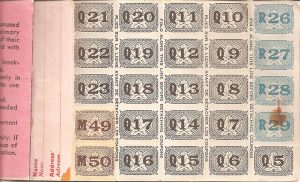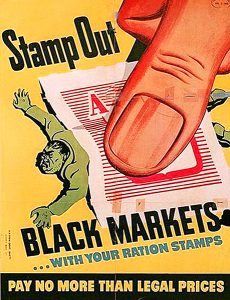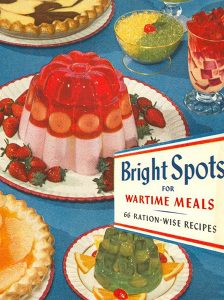Home »

Wartime rations meant Canadian cooks got creative
By Elinor Florence
For five long years during the Second World War and beyond, consumption of sugar, meat and dairy products was restricted in Canada, but we didn’t complain. Not only were we feeding the desperate British population, but also our fighting servicemen overseas, prisoners of war and starving refugees.
Wartime rations can be boiled down to one word: vegetables. People may have suffered from a bland and boring diet, but it certainly didn’t lack fibre! And the shortage of meat, sugar and alcohol possibly resulted in healthier eating habits than those of today.
For Canadians, this was the ultimate exercise in sharing what we had with the less fortunate. Since Great Britain was virtually cut off, our food exports provided an essential lifeline to the mother country.
By the end of the war, Canadian exports accounted for 57 per cent of all wheat and flour, 39 per cent of bacon, 24 per cent of cheese, and 15 per cent of eggs consumed in Britain.
Not only were we feeding Britain, we were sending an enormous amount of food to our own fighting forces overseas, prisoners of war, and starving refugees from war-torn countries.
Optimistic and determined by nature, many Canadians stretched their war rations by planting Victory Gardens, canning and preserving foods (there was an extra “canning ration” of sugar), fishing, hunting, and recycling every last scrap of food.
Eleven million ration cards (lead image) were issued in Canada.
 Inside there were coupons issued for such things as sugar, butter and meat.
Inside there were coupons issued for such things as sugar, butter and meat.
For the first few years, from 1939 to 1941, Canadians were willing volunteers. Rationing was introduced in January 1942 to ensure equal treatment for everyone. It guaranteed that (for the most part) there would be no hoarding and no profiteering. Food hoarders were considered no better than criminals!
 Canadians may have grumbled about the food shortages, but on the whole they were willing participants. Australia, New Zealand, and the United States also had rationing.
Canadians may have grumbled about the food shortages, but on the whole they were willing participants. Australia, New Zealand, and the United States also had rationing.
There was massive sympathy for the beleaguered British people, who were far worse off than us. Britain was fighting for its life, and everyone knew it.
In Britain, rationing began in 1940 and didn’t end until 1954. If you were a child born at the beginning of the war, you wouldn’t have eaten “normally” until you were a teenager, and wouldn’t even know the difference!

Here in Canada, rationing began in 1942 but didn’t end until 1947.
Just how bad was it?
Today we eat such an assortment of imported foods that we no longer think of them as exotic. Sushi. Pizza. Strawberries and oranges in the dead of winter. But during the war, importing food into Canada became very difficult as many merchant ships were taken over by the military, and many others were sunk by German submarines. So you could pretty much forget about eating anything that wasn’t produced here in Canada.
Even the most basic foods that we produced here were restricted: bacon, steak, pork chops. Butter and cheese and ice cream. You ate what you could prepare and cook at home, and often grow yourself.
Exact quantities varied throughout the war. Basically, this is what we were allowed:
Weekly Rations Per Adult:
Sugar: one cup (the average Canadian eats twice that much today)
Tea: two ounces, OR Coffee: eight ounces. (because these items came from other countries)
Butter: four ounces (one-quarter pound)
Meat: 24-32 ounces (less than five ounces per day)
Beer, spirits and wine were also rationed, but the amount varied between provinces.
 Needless to say, there were very few leftovers. Besides, wasting food was considered absolutely unpatriotic.
Needless to say, there were very few leftovers. Besides, wasting food was considered absolutely unpatriotic.
Canadian culinary historian Mary F. Williamson of York University in Toronto wrote an article about wartime rationing, and quoted from one of her mother’s letters in September 1942. “We are asked not to use any pork or bacon for seven weeks while our commitments to Britain are being filled, there is no beef at all for sale (I think a lot is being sent to Russia), the sheep raisers are asked not to slaughter in order to raise more badly-needed wool, so a great many butchers have shut up shop.”
Because meat was scarce, a food item was invented that was found on almost every table during the war and beyond. Short for “Seasoned Ham,” Spam was a processed meat product that people ate in great quantities.
 Rural dwellers were better off
Rural dwellers were better off
Since lower-income families were already accustomed to “making do” and eating a plain diet, it was the middle-income and upper-income families who felt the greatest loss of luxury food items. And city dwellers were worse off than people who lived on or near farms.
My own mother June Light Florence recalls that her family ate quite well. Her father was the postmaster in the small town of Battleford, Saskatchewan. He was an avid hunter and brought home lots of fresh game and fish, which were not rationed.
Her entire family (two adults, five children) picked berries as if their lives depended on it. An extra ten pounds of sugar per person was available to the housewife who preserved berries and fruit, which provided almost the only desserts during the war.
Of course I can!
 My mother’s uncle owned a farm that supplied them with fresh eggs and dairy products. It’s a good thing, too, since they entertained boys from the nearby British Commonwealth Air Training base in North Battleford every single weekend for years.
My mother’s uncle owned a farm that supplied them with fresh eggs and dairy products. It’s a good thing, too, since they entertained boys from the nearby British Commonwealth Air Training base in North Battleford every single weekend for years.
She recalls a funny story about entertaining one of the newly-arrived airmen from England.
“We sat down in the dining room to have supper, and my mother brought in a platter of beefsteaks. They were cut small, each one about four ounces, so there would be enough to go around. Realizing she had forgotten her hot dish mat, Mother set the meat platter down on the nearest plate and went back into the kitchen to find it.
“I guess the English guy must have thought Canadians had oodles of meat, and this was his portion. He piled mashed potatoes on the side of the platter, and then tucked into his steak.
“Mother came back into the dining room without noticing, and she just picked up the platter and started passing it around. Everyone else took a steak. The poor airman was very embarrassed, but nobody said anything!”
 What my mother remembers missing the most was sweets. My grandmother made a lot of jellied salads in those days, filling the jelly with all types of fruit so that she wouldn’t need to sweeten them with sugar. But oh, how they wished they could mix up a big batch of fudge, or slather icing all over a cake!
What my mother remembers missing the most was sweets. My grandmother made a lot of jellied salads in those days, filling the jelly with all types of fruit so that she wouldn’t need to sweeten them with sugar. But oh, how they wished they could mix up a big batch of fudge, or slather icing all over a cake!
It appears that jellied salads were a big item back then.
The nuisance factor
Think about going into a grocery store today and not buying a single pre-packaged, pre-prepared item. Everything had to be peeled and chopped and made from scratch. This must have been very demanding for women who were also working outside the home. It was so darned much work that Canadian homemakers were nicknamed “Housoldiers.”
Not only that, but having a ration card didn’t guarantee those items would be available.
According to Mary Williamson’s mother, by Christmas 1943 food was in short supply. “Christmas dinner will be simple, but all the festive additives are either not to be had, or are only obtained by hours of journeying from shop to shop and standing in line here there and everywhere.”
 Meals also required an immense amount of planning ahead. Larger families had the advantage, because the homemaker had more flexibility in deciding how to organize her meal plan.
Meals also required an immense amount of planning ahead. Larger families had the advantage, because the homemaker had more flexibility in deciding how to organize her meal plan.
On the other hand, children were probably pressed into service to do some of the work. Certainly the kids were persuaded to accept rations. This photo of children in Britain shows kids eating carrots on sticks!
Was the rationed diet healthy?
Opinion is divided. There wasn’t a lot of protein, and some available foods were quite starchy. In fact, the Canada Food Guide was created in 1942 as a response to concerns that people were malnourished.
On the other hand, people ate about half as much food overall, so obesity wasn’t a problem. And neither was getting your eight servings of vegetables every day!
As meat became more difficult to find, root vegetables were became a staple part of everyone’s diet. In England alone, production of potatoes went from five million pounds to 10 million.
Turnips were also found on the wartime menu. Here’s one recipe, taken from a booklet titled ‘Wartime Recipes From the Maritimes.’
Glazed Turnips
2 tablespoons butter
1 tablespoon sugar
1/2 tablespoon flour
1/2 cup stock
Method:
Pre-heat oven to medium-hot.
Dice turnips into one-inch chunks and cook in salted water for 10 minutes.
Drain well, then saute in hot butter for a few minutes.
Sprinkle the sugar and flour over and continue to fry until browning.
Place into ovenproof dish and add half cup of stock.
Bake in oven for 15 minutes until further browned.
Sprinkle with salt and pepper before serving.
And here’s another for bread pudding, using a very small amount of precious sugar.
Bread Pudding
 10 ounces of stale bread (use your kitchen scales!)
10 ounces of stale bread (use your kitchen scales!)
2 ounces of margarine or butter
1 ounce of sugar
2 ounces of dried raisin sultanas
1 egg (fresh or dried)
Milk to mix
Cinnamon
Extra sugar for topping
Method:
Put bread into a basin and add a little water. Leave for 10 minutes.
Squeeze bread out until fairly dry.
Return bread to empty basin and add all the other ingredients (except spice) adding a little milk to make a sticky consistency.
Add cinnamon a little at a time until your own taste.
Place mixture into a greased pan (like a lasagna pan).
Cook at 160C for an hour or so until edges are browned and centre is hot.
Sprinkle sugar on top 10 minutes before end of cooking.
Allow to cool a little, slice and serve.
Serves 8 to 10.
In conclusion, here’s a handy little device that I think could be marketed today. Called a V-for-Victory Sugar Spoon, it has a V-shaped opening that allows most of the sugar to fall back into the bowl!
 – Career journalist and bestselling author Elinor Florence of Invermere has released a new book titled My Favourite Veterans: True Stories From World War Two’s Hometown Heroes. Many of these veterans are men and women whose stories appeared previously on e-KNOW, including Cranbrook’s own Bud Abbott and Jim Ashworth of Invermere. To order your copy, email Elinor at [email protected] or call her at 250-342-1621.
– Career journalist and bestselling author Elinor Florence of Invermere has released a new book titled My Favourite Veterans: True Stories From World War Two’s Hometown Heroes. Many of these veterans are men and women whose stories appeared previously on e-KNOW, including Cranbrook’s own Bud Abbott and Jim Ashworth of Invermere. To order your copy, email Elinor at [email protected] or call her at 250-342-1621.
Elinor’s first historical novel, Bird’s Eye View, has now reached national bestseller status. This tells the story of an idealistic Saskatchewan farm girl who joins the Royal Canadian Air Force and becomes an interpreter of aerial photographs. The book is available through any bookstore, and as an ebook. For more info, visit Elinor’s website at www.elinorflorence.com.









